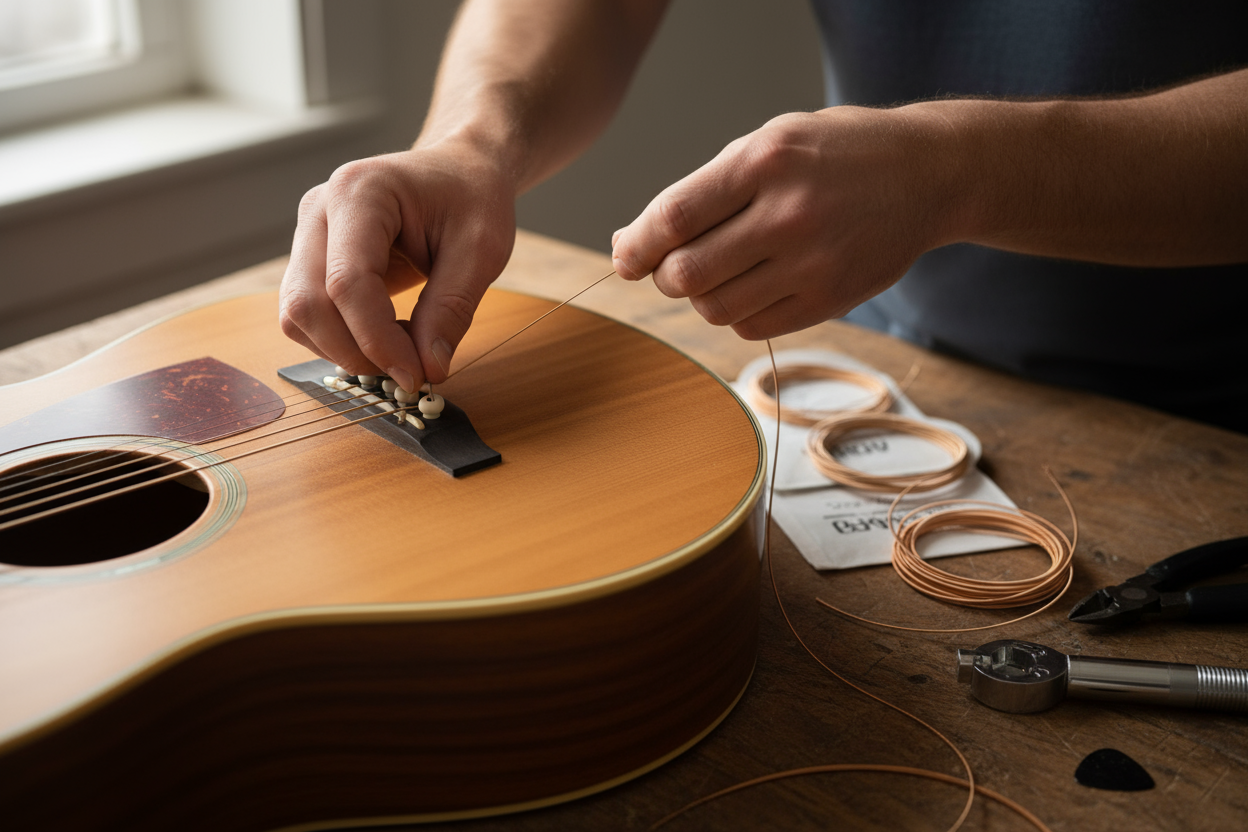How to Restring Your Guitar and Other Stringed Instruments: A Complete Step-by-Step Guide
Master the essential skill of restringing your guitar, bass, or ukulele with confidence. Fresh strings bring new life to your sound, improve tuning stability, and make playing feel effortless. This comprehensive guide walks you through everything from selecting the right strings to tuning your instrument perfectly.
Key Takeaways
- Regular restringing enhances tone, playability, and tuning stability.
- Choosing the right string type and gauge for your instrument is crucial.
- Having the proper tools like string winders and wire cutters simplifies the process.
- Step-by-step methods vary between acoustic, electric, bass guitars, and ukuleles.
- Proper stretching and maintenance extend string life and keep your instrument in top shape.
Table of Contents
- Why Restringing Matters
- Must-Have Tools for Restringing
- Choosing the Right Strings
- Restringing an Acoustic Guitar
- Restringing an Electric Guitar
- Restringing a Ukulele
- Restringing a Bass Guitar
- How Often Should You Change Your Strings?
- Pro Tips for Tuning Stability and Longevity
- When to Get a Professional Setup
- FAQ
Why Restringing Matters: The Sound and Feel of Fresh Strings
Strings are the voice of your instrument, and over time, that voice weakens. Regularly replacing strings is essential because:
- Rust and Wear: Sweat and moisture cause corrosion, dulling tone and potentially harming frets.
- Breakage Risk: Old strings snap unpredictably, so keeping spares is key.
- Tonal Exploration: Different string materials and coatings let you experiment with sound.
- Smoother Playability: New strings reduce finger fatigue and improve responsiveness.
- Better Tuning Stability: Fresh strings stretch and settle predictably, holding pitch longer.
Aim to replace strings every 1 to 3 months, adjusting frequency based on how often you play.
Must-Have Tools for Restringing Success
Gather these tools to make restringing easier and protect your instrument:
- New Strings: Tailored to your instrument and sound preference.
- String Winder: Speeds up string winding and eases wrist strain.
- Wire Cutters: Neatly trims string ends for safety and comfort.
- Tuner: Clip-on or digital for precise pitch adjustment.
- Cleaning Supplies: Guitar-safe sprays and microfiber cloths to maintain finish and fretboard.
- Bridge Pin Puller: Essential for removing pins on acoustic guitars without damage.
Choosing the Right Strings for Your Instrument
Your string choice defines your tone, playability, and durability. Consider these options:
- Acoustic Guitars: Phosphor bronze for warmth and longevity; 80/20 bronze for brightness; coated strings for extended life.
- Electric Guitars: Nickel-plated steel for balanced tone; stainless steel for brightness; flatwound for smooth vintage vibes.
- Bass Guitars: Roundwound for punchiness; flatwound for smooth jazz tones; halfwound for versatility.
- Ukuleles: Nylon for mellow tone; fluorocarbon for brightness and durability; wound metal for enhanced bass response.
Step-by-Step: Restringing an Acoustic Guitar
- Remove Old Strings: Place your guitar on a stable surface. Loosen strings with a winder or by hand, cut near the middle, and carefully pull out strings and bridge pins using a bridge pin puller if necessary.
- Clean the Guitar: Wipe the fretboard, headstock, and body with guitar cleaner and a microfiber cloth.
- Install New Strings: Insert the ball end into bridge holes, secure pins with grooves aligned properly, and thread strings through tuners.
- Wind the Strings: Leave 1.5 to 2 inches slack and wind neatly with 2–3 wraps, ensuring coils don’t overlap and direction matches your headstock.
- Tune and Stretch: Tune each string to pitch, gently stretch above the 12th fret, and retune until stable.
Your acoustic guitar is now ready for rich, clear sound.
Step-by-Step: Restringing an Electric Guitar
- Remove Old Strings: Lay your guitar flat or on a stand, loosen and cut strings, unwind from tuners, and pull ball ends through the bridge or body.
- Clean the Guitar: Clean fretboard, pickups, and hardware while strings are off.
- Install New Strings: Insert ball ends through bridge or body slot, thread toward headstock, and feed through tuning peg holes.
- Wind the Strings: Leave 1.5 to 2 inches slack. Wind 2–3 wraps neatly. For 6-in-line headstocks, wind all strings in the same direction; for 3+3 headstocks, wind accordingly on each side.
- Tune and Stretch: Tune each string, stretch near the 12th fret, and retune until stable.
Your electric guitar is now primed for bold, vibrant tone.
Step-by-Step: Restringing a Ukulele
- Remove Old Strings: Loosen, unwind, and gently remove strings from both bridge and tuners.
- Clean the Instrument: Wipe down fretboard and body with a ukulele-safe cleaner.
- Attach New Strings: Tie a secure knot at the bridge (overhand or slip knot), then pull the string toward the headstock and feed it through the tuning peg hole.
- Wind Securely: Wind with 2–3 wraps around the peg. Note common tuning is G–C–E–A, with some using reentrant tuning where the G string is higher-pitched.
- Tune and Stretch: Tune each string and retune several times as nylon strings stretch significantly.
Your ukulele is now ready to produce its signature bright and bouncy tones.
Step-by-Step: Restringing a Bass Guitar
- Remove Old Strings: Loosen and cut strings. Remove from tuners and pull ball ends through bridge or body.
- Clean Up: Wipe the fretboard, neck, and body using a microfiber cloth and cleaner.
- Install New Strings: Thread strings through bridge or body holes, pull upward to the headstock, and insert into tuning pegs.
- Wind the Strings: Leave 1.5 to 2 inches slack and wind 2–3 wraps neatly around posts. Standard tuning is E–A–D–G from lowest to highest.
- Tune and Stretch: Tune, stretch gently, and retune until pitch is stable.
Bass strings come in different variations for tone and feel: roundwound for bright punch, flatwound for smooth depth, and halfwound for balance.
How Often Should You Change Your Strings?
Your playing frequency and environment affect string life:
- Daily Players: Change strings approximately every month or as needed.
- Occasional Players: Every 2–3 months usually suffices.
- Watch for Signs: Rust spots, discoloration, tuning instability, or buzzing indicate it’s time to replace.
Pro Tips for Tuning Stability and String Longevity
- Stretch New Strings: Gently pull each string after tuning to speed up settling.
- Lubricate Nut and Saddle: Use graphite or string lubricant to reduce friction and prevent breakage.
- Wipe Strings After Playing: Remove oils and sweat to slow corrosion.
- Get Regular Setups: Every 6–12 months, a professional can optimize neck relief, action, intonation, and pickups.
When to Get a Professional Setup
If fresh strings don’t solve playability or tuning issues, consider a professional setup. These typically cost $50–$100 and include:
- Cleaning and restringing
- Truss rod adjustments
- Action and intonation tweaks
- Pickup height adjustments (for electrics)
- Minor fretwork
A good setup can transform your instrument’s comfort and tone, making playing much more enjoyable.
FAQ
How do I know when my strings need changing?
Signs include rust, discoloration, frequent tuning problems, buzzing, or loss of tone brightness. If strings feel rough or difficult to play, it’s time to replace them.
Can I restring my guitar without special tools?
While you can loosen and replace strings by hand, having tools like a string winder, wire cutters, and a tuner makes the process much smoother and quicker.
Why do new strings keep going out of tune?
New strings stretch a lot initially and need frequent tuning and gentle stretching. Lubricating the nut and saddle can also help reduce tuning problems.
Are coated strings worth the extra cost?
Coated strings last longer and resist grime buildup, which can save money over time despite higher upfront cost. Tonally, some players feel they are slightly less bright.
Where can I buy quality strings and tools?
Visit trusted retailers like Sweetwater or your local music store. Online shops such as Creative Soul Music offer a wide selection and expert advice.
Ready to upgrade your strings and tools? Check out reliable options at Emusicmart and keep your instrument sounding its best.








